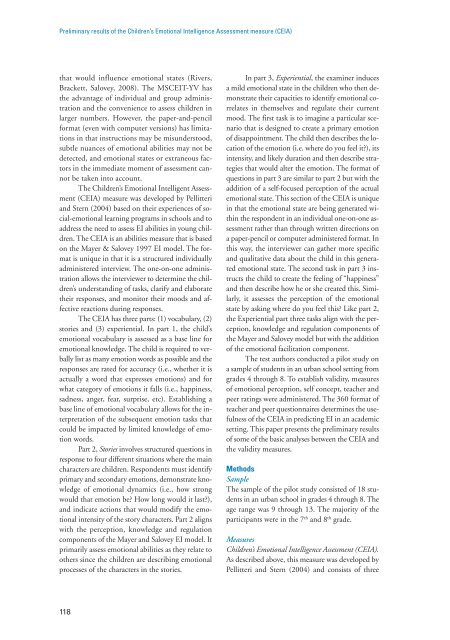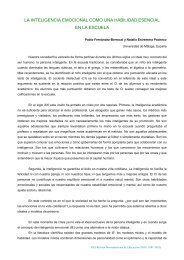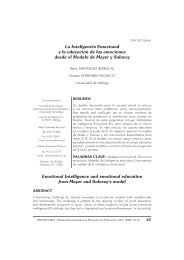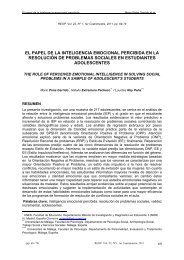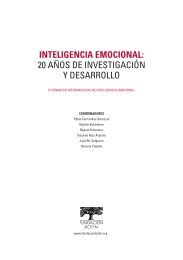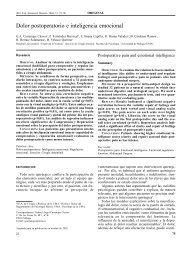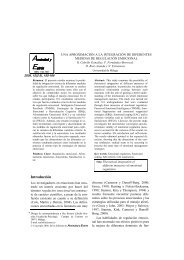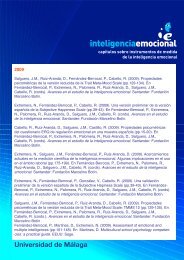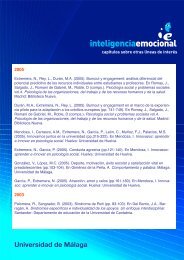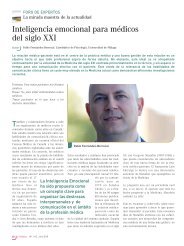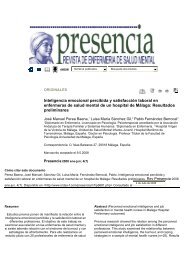Avances en el estudio de la Inteligencia Emocional
Avances en el estudio de la Inteligencia Emocional
Avances en el estudio de la Inteligencia Emocional
You also want an ePaper? Increase the reach of your titles
YUMPU automatically turns print PDFs into web optimized ePapers that Google loves.
Pr<strong>el</strong>iminary results of the Childr<strong>en</strong>’s Emotional Int<strong>el</strong>lig<strong>en</strong>ce Assessm<strong>en</strong>t measure (CEIA)<br />
that would influ<strong>en</strong>ce emotional states (Rivers,<br />
Brackett, Salovey, 2008). The MSCEIT-YV has<br />
the advantage of individual and group administration<br />
and the conv<strong>en</strong>i<strong>en</strong>ce to assess childr<strong>en</strong> in<br />
<strong>la</strong>rger numbers. However, the paper-and-p<strong>en</strong>cil<br />
format (ev<strong>en</strong> with computer versions) has limitations<br />
in that instructions may be misun<strong>de</strong>rstood,<br />
subtle nuances of emotional abilities may not be<br />
<strong>de</strong>tected, and emotional states or extraneous factors<br />
in the immediate mom<strong>en</strong>t of assessm<strong>en</strong>t cannot<br />
be tak<strong>en</strong> into account.<br />
The Childr<strong>en</strong>’s Emotional Int<strong>el</strong>lig<strong>en</strong>t Assessm<strong>en</strong>t<br />
(CEIA) measure was <strong>de</strong>v<strong>el</strong>oped by P<strong>el</strong>litteri<br />
and Stern (2004) based on their experi<strong>en</strong>ces of social-emotional<br />
learning programs in schools and to<br />
address the need to assess EI abilities in young childr<strong>en</strong>.<br />
The CEIA is an abilities measure that is based<br />
on the Mayer & Salovey 1997 EI mod<strong>el</strong>. The format<br />
is unique in that it is a structured individually<br />
administered interview. The one-on-one administration<br />
allows the interviewer to <strong>de</strong>termine the childr<strong>en</strong>’s<br />
un<strong>de</strong>rstanding of tasks, c<strong>la</strong>rify and <strong>el</strong>aborate<br />
their responses, and monitor their moods and affective<br />
reactions during responses.<br />
The CEIA has three parts: (1) vocabu<strong>la</strong>ry, (2)<br />
stories and (3) experi<strong>en</strong>tial. In part 1, the child’s<br />
emotional vocabu<strong>la</strong>ry is assessed as a base line for<br />
emotional knowledge. The child is required to verbally<br />
list as many emotion words as possible and the<br />
responses are rated for accuracy (i.e., whether it is<br />
actually a word that expresses emotions) and for<br />
what category of emotions it falls (i.e., happiness,<br />
sadness, anger, fear, surprise, etc). Establishing a<br />
base line of emotional vocabu<strong>la</strong>ry allows for the interpretation<br />
of the subsequ<strong>en</strong>t emotion tasks that<br />
could be impacted by limited knowledge of emotion<br />
words.<br />
Part 2, Stories involves structured questions in<br />
response to four differ<strong>en</strong>t situations where the main<br />
characters are childr<strong>en</strong>. Respond<strong>en</strong>ts must id<strong>en</strong>tify<br />
primary and secondary emotions, <strong>de</strong>monstrate knowledge<br />
of emotional dynamics (i.e., how strong<br />
would that emotion be? How long would it <strong>la</strong>st?),<br />
and indicate actions that would modify the emotional<br />
int<strong>en</strong>sity of the story characters. Part 2 aligns<br />
with the perception, knowledge and regu<strong>la</strong>tion<br />
compon<strong>en</strong>ts of the Mayer and Salovey EI mod<strong>el</strong>. It<br />
primarily assess emotional abilities as they r<strong>el</strong>ate to<br />
others since the childr<strong>en</strong> are <strong>de</strong>scribing emotional<br />
processes of the characters in the stories.<br />
In part 3, Experi<strong>en</strong>tial, the examiner induces<br />
a mild emotional state in the childr<strong>en</strong> who th<strong>en</strong> <strong>de</strong>monstrate<br />
their capacities to id<strong>en</strong>tify emotional corr<strong>el</strong>ates<br />
in thems<strong>el</strong>ves and regu<strong>la</strong>te their curr<strong>en</strong>t<br />
mood. The first task is to imagine a particu<strong>la</strong>r sc<strong>en</strong>ario<br />
that is <strong>de</strong>signed to create a primary emotion<br />
of disappointm<strong>en</strong>t. The child th<strong>en</strong> <strong>de</strong>scribes the location<br />
of the emotion (i.e. where do you fe<strong>el</strong> it?), its<br />
int<strong>en</strong>sity, and lik<strong>el</strong>y duration and th<strong>en</strong> <strong>de</strong>scribe strategies<br />
that would alter the emotion. The format of<br />
questions in part 3 are simi<strong>la</strong>r to part 2 but with the<br />
addition of a s<strong>el</strong>f-focused perception of the actual<br />
emotional state. This section of the CEIA is unique<br />
in that the emotional state are being g<strong>en</strong>erated within<br />
the respond<strong>en</strong>t in an individual one-on-one assessm<strong>en</strong>t<br />
rather than through writt<strong>en</strong> directions on<br />
a paper-p<strong>en</strong>cil or computer administered format. In<br />
this way, the interviewer can gather more specific<br />
and qualitative data about the child in this g<strong>en</strong>erated<br />
emotional state. The second task in part 3 instructs<br />
the child to create the fe<strong>el</strong>ing of “happiness”<br />
and th<strong>en</strong> <strong>de</strong>scribe how he or she created this. Simi<strong>la</strong>rly,<br />
it assesses the perception of the emotional<br />
state by asking where do you fe<strong>el</strong> this? Like part 2,<br />
the Experi<strong>en</strong>tial part three tasks align with the perception,<br />
knowledge and regu<strong>la</strong>tion compon<strong>en</strong>ts of<br />
the Mayer and Salovey mod<strong>el</strong> but with the addition<br />
of the emotional facilitation compon<strong>en</strong>t.<br />
The test authors conducted a pilot study on<br />
a sample of stud<strong>en</strong>ts in an urban school setting from<br />
gra<strong>de</strong>s 4 through 8. To establish validity, measures<br />
of emotional perception, s<strong>el</strong>f concept, teacher and<br />
peer ratings were administered. The 360 format of<br />
teacher and peer questionnaires <strong>de</strong>termines the usefulness<br />
of the CEIA in predicting EI in an aca<strong>de</strong>mic<br />
setting. This paper pres<strong>en</strong>ts the pr<strong>el</strong>iminary results<br />
of some of the basic analyses betwe<strong>en</strong> the CEIA and<br />
the validity measures.<br />
Methods<br />
Sample<br />
The sample of the pilot study consisted of 18 stud<strong>en</strong>ts<br />
in an urban school in gra<strong>de</strong>s 4 through 8. The<br />
age range was 9 through 13. The majority of the<br />
participants were in the 7 th and 8 th gra<strong>de</strong>.<br />
Measures<br />
Childr<strong>en</strong>’s Emotional Int<strong>el</strong>lig<strong>en</strong>ce Assessm<strong>en</strong>t (CEIA).<br />
As <strong>de</strong>scribed above, this measure was <strong>de</strong>v<strong>el</strong>oped by<br />
P<strong>el</strong>litteri and Stern (2004) and consists of three<br />
118


